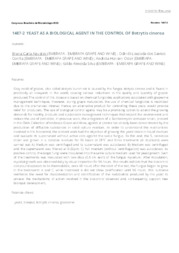Yeast as a biological agent in the control of botrytis cinerea.
Yeast as a biological agent in the control of botrytis cinerea.
Author(s): AGUSTINI, B. C.; CORREA, O. L. dos S.; OSTER, A. H.; SILVA, G. A.
Summary: Gray mold of grapes, also called Botrytis bunch rot is caused by the fungus Botrytis cinerea and is found in practically all vineyards in the world, causing serious reductions in the quality and quantity of grapes produced. The control of this disease is based on chemical fungicides applications associated with grapevine management techniques. However, during grape maturation, the use of chemical fungicides is restricted due to the pre-harvest interval. Hence, an alternative product for controlling these pests would provide relief for producers. The use of biological control agents may be a promising option to attend the growing demands for healthy products and sustainable management techniques that respect the environment and reduce the use of pesticides. In previous work, the antagonism of a Saccharomyces cerevisiae strain, present in the CMIA Collection of Embrapa Grape and Wine, against B. cinerea has already been demonstrated by the production of diffusible substances in solid culture medium. In order to understand the mechanisms involved in this biocontrol, the present work had the objective of growing this yeast strain in liquid medium and evaluate its supernatant without active cells against the same fungus. To this end, the S. cerevisiae strain was grown in a complex medium for 96 hours at 28°C and three treatments (in duplicate) were carried out: A) Medium was centrifuged and its supernatant was autoclaved; B) Medium was centrifuged and the supernatant was filtered at 0.22µm; C) Full medium (without centrifugation) was autoclaved. As positive control, the target fungi were inoculated into the same culture medium used for yeast growth. Each of the treatments was inoculated with two discs (0.5 cm each) of the fungus mycelium. After inoculation, mycelial growth was observed daily by visual inspection for 96 hours. The results indicate that the biocontrol compound appears to be thermolabile, once 48 hours after the start of the test, the fungus began to grow in the treatments A and C, while treatment B did not show proliferation until 96 hours. This outcome reinforces the need for characterization and identification of the metabolites produced by the yeast to unravel the mechanisms of action involved in the biocontrol observed and, consequently, support new bioinput development.
Publication year: 2023
Types of publication: Abstract in annals or event proceedings
Unit: Embrapa Grape & Wine
Keywords: Bionput, Botrytis Cinerea, Grapevine, Yeast
Observation
Some of Embrapa's publications are published as ePub files. To read them, use or download one of the following free software options to your computer or mobile device. Android: Google Play Books; IOS: iBooks; Windows and Linux: Calibre.
Access other publications
Access the Agricultural Research Database (BDPA) to consult Embrapa's full library collection and records.
Visit Embrapa Bookstore to purchase books and other publications sold by Embrapa.

